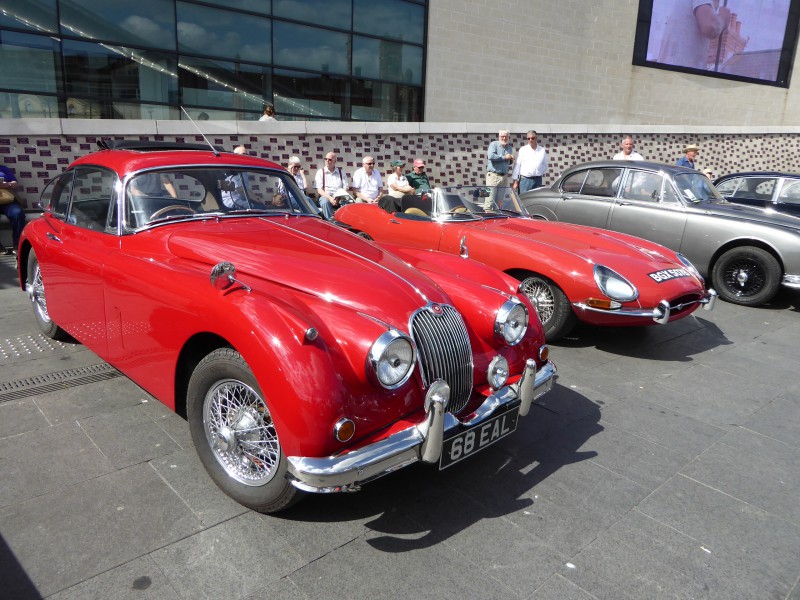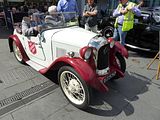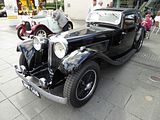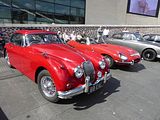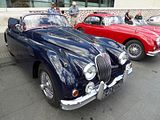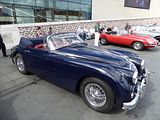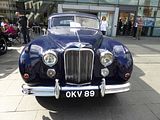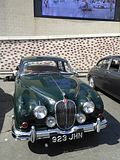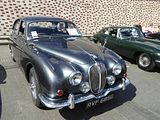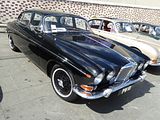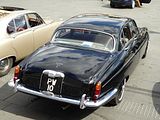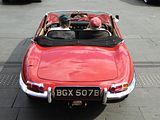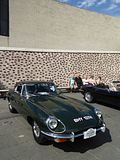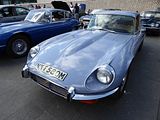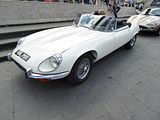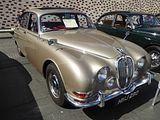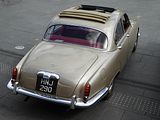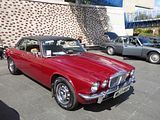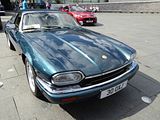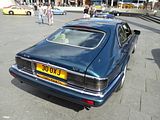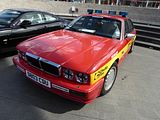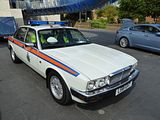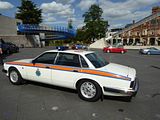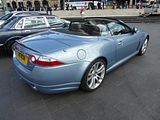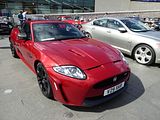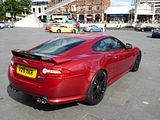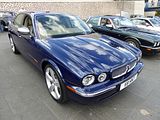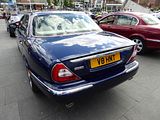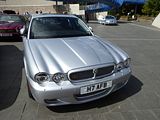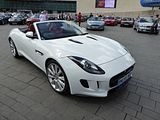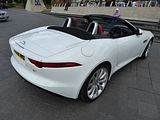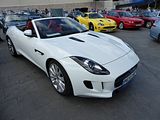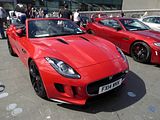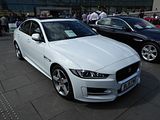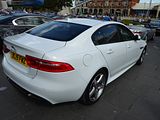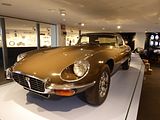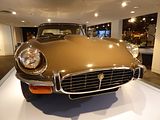Coventry has been home to Jaguar from only a few years after the marque was founded. The story starts in 1922, when the Swallow Sidecar Company was founded by two motorcycle enthusiasts, William Lyons and William Walmsley, who started out making coachbuilt sidecars for motorcycles of the period. In 1927 they announced that they intended to develop their offerings to include their own coachbuilt bodies on the chassis of Austin and Morris cars. Early production was in Blackpool, but when demand exceeded the capacity of the factory to build the cars quickly enough, the company relocated to Coventry, and it has remained there ever since. A lot has happened since those early days of building a car that was largely based on someone else’s product, of course. In 1934 Walmsley elected to sell-out and Lyons formed S. S. Cars Limited funding the replacement of Walmsley’s investment by issuing shares to the public. The SS Jaguar name first appeared in September 1935 on a 2.5-litre saloon, sports models of which were the SS 90 and SS 100. On 23 March 1945 the S. S. Cars shareholders in general meeting agreed to change the company’s name to Jaguar Cars Limited, as the letters “SS” had rather unfortunate connatations with the about to be defeated Nazi party. Jaguar has something of a roller-coaster type existence since then, with changes in their fortunes resulting in several changes of ownership. Despite these challenges, Coventry has remained home to the marque. For much of the past century, there have been plenty of other car manufacturers in the area, but when in 2006, Peugeot closed their plant at Ryton, the honour for being sole Covenry car manufacturer remaining fell to the organisation that is now called Jaguar Land Rover. It may no longer be British owned, but there is a confidence exuding from every pore of JLR at present, with a range of vehicles every single one of which has been acclaimed by the Press to be not just excellent but at or near the very top of their class, resulting in a challenge to be able to build the products fast enough. And there’s more to come. Considering the roller-coaster of future prospects that have confronted Jaguar in the past 40 years, from the dark days of strike-ridden BL and a deserved reputation for patchy build quality and poor reliability in the 1970s, to the glimmers of hope from the Ford acquisition quickly extinguished when Ford did what all US companies, and abuse non domestic parts of their empire to protect the American bit, and then the dark days post sell-off when it looked there were not going to be enough funds to develop much needed new models, it is heart warming to see not just that the current cars are so well liked, but that the back-catalogue has its fans as well. So when the newly recreated Coventry Motor Museum announced that it would hold a Jaguar Super Saturday, for the third year running, it was a pretty sure bet that it would be well attended. I’d not been to this before, but the event publicity advised that in 2014 there had been a mix of some 65 Jaguars, Daimlers and SS cars, plus one very early Swallow, parked up on display in Millennium Place right outside the museum entrance, available to inspect all day long, it seemed to good an opportunity to miss not to come and have a look at the 2015 collection. Logistics were such that I did not arrive until mid afternoon, only just in time to catch the cars, as soon after I got there, they all started to depart, but there was still just about enough time to see a variety of models and refresh my mind with a history lesson in some of the greats that this marque has produced.
Oldest car on show was an example of the very first model that the fledging Swallow Sidecar Company produced. When Lyons and Walmsley decided to move into car production, the first model that they looked to as a base for their ideas was the Austin 7, a popular and inexpensive vehicle. For their show car Swallow’s Bolton, Lancashire agent had persuaded a dealer in Bolton to supply him under-the-counter (coachbuilders required Austin’s prior approval or warranties might be voided) with an Austin 7 chassis. Lyons, with a sketch of what he wanted, commissioned Cyril Holland, a coachbuilder by trade, to create a distinctive, open two seater body. Holland gave it a detachable hardtop with a characteristic back window. The result was announced to public in May 1927, the Austin Seven Swallow. Austin gave their approval to the Swallow coachwork though adjustments were needed, the wings kept falling onto the tyres and the cycle type was dispensed with in favour of the more usual shape. In that form it was taken to London and shown to Henlys — Bert (Herbert Gerald) Henly and Frank Hough — who ordered 500 both two-seaters and saloons. Priced at only £175, the Swallow, with its brightly coloured two-tone bodywork and a style that imitated the more expensive cars of the time, proved popular in the prosperous late twenties and in the following depression. Soon after, a saloon version was produced: the Austin Seven Swallow Saloon, and the model seen here is one of these, dating from 1931.
The early 1930s were tough times for those making cars, as the effects of the Great Depression took hold, but under the guidance of the chairman, William Lyons, the SS Company survived by making a series of beautifully styled cars offering exceptional value for money although some enthusiasts criticised them at the time for being “more show than go”. The engines and chassis supplied by the Standard Motor Company were fitted with Swallow bodies styled under Lyons supervision. The first of these SS range of cars available to the public was the 1932 SS 1, which was available with either a 2-litre or 2½-litre side-valve, six-cylinder engine and it was followed by the SS 2 with a four-cylinder 1-litre side-valve engine. Seen here is an SS1 Coupe from 1935.
The first of the open two-seater sports cars came in March 1935 with the SS 90, so called because of its claimed 90 mph top speed. This car used the 2½-litre side-valve, six-cylinder engine in a short-chassis “cut and shut” SS 1 brought down to an SS 2’s wheelbase. Just 23 were made. It was the precursor to one of the finest pre-war sports car ever made, the SS100. That car benefitted from some significant engine development work that was led by Harry Westlake, who was asked to redesign the 2½-litre 70 bhp side-valve engine to achieve 90 bhp. His answer was an overhead-valve design that produced 102 bhp and it was this engine that launched the new SS Jaguar sports and saloon cars in 1936. Shown first in the SS Jaguar 2½-litre saloon, the new car caused a sensation when it was launched at a trade luncheon for dealers and press at London’s Mayfair Hotel on 21 September 1935. The show car was in fact a prototype. Luncheon guests were asked to write down the UK price for which they thought the car would be sold and the average of their answers was £765. Even in that deflationary period, the actual price at just £395 would have been a pleasant surprise for many customers, something which characterised Jaguars for many decades to come. Whilst the new Jaguar saloon could now compete with the brand new MG SA, it was the next application of the engine that stunned everyone even more, with the launch of the legendary SS100. Named because it was a genuine 100 mph car, this open topped sports car looked as good as it was to drive. Only 198 of the 2½-litre and 116 of the 3½-litre models were made and survivors are highly prized and priced on the rare occasions when they come on the market. Such is their desirability that a number of replica models have been made over the years, with those made by Suffolk Engineering being perhaps the best known, and which are indeed hard to tell apart from an original 1930s car at a glance. This is not one of those, and indeed a quick glance will tell you that it clearly is not an original, but even so it clearly brings its own plenty of pleasure.
Although bearing a clear resemblance to the earlier XK120 and XK140, the XK150, which was launched in 1957, was a significant revision. The car is easily distinguished from the XK120 and XK140 models. A one-piece windscreen replaced the split screen, and the wing line no longer dropped so deeply at the doors. The widened bonnet opened down to the wings, and on the Roadster the windscreen frame was moved back 4″ to make the bonnet longer. The car was available at various times in Red, Pearl Grey, White, Indigo Blue, Claret, Cotswold Blue, Black, Mist Grey, Sherwood Green, Carmen Red, British Racing Green, Cornish Grey, and Imperial Maroon. The XK140’s walnut dashboard was replaced by one trimmed in leather. On the early Drophead Coupés, the aluminium centre dash panel, which was discontinued after June 1958, had an X pattern engraving similar to the early 3.8 E-type. Thinner doors gave more interior space. On the front parking lights, which were located atop the wings, a little red light reminded the driver the lights were on. The Suspension and chassis were very similar to the XK140, and steering was by rack and pinion. Power steering was not offered. The standard engine, similar to the XK140, but with an new “B” type cylinder head, was the 3.4 litre DOHC Jaguar straight-6 rated at 180 SAE bhp at 5750 rpm but most cars were fitted with the SE engine whose modified cylinder head (B type) and larger exhaust valves boosted the power to 210 SAE bhp at 5500 rpm. Twin SU HD6 carburettors were fitted. The first XK150s were slower than their predecessors, but this was addressed in the spring of 1958 with a 3.4-litre “S” engine whose three SU HD8 carburettors and straight-port cylinder head increased power to a claimed 250 SAE bhp. For 1960, the 3.4 litre engine was bored to 3.8 litres, rating this option at 220 hp in standard tune or 265 hp in “S” form. A 3.8 litre 150S could top 135 mph and go from 0–60 mph in around 7.0 seconds. Fuel economy was 18mpg.Four-wheel Dunlop 12″disc brakes appeared for the first time although it was theoretically possible to order a car with drums. When leaving the factory the car originally fitted either 6.00 × 16″ Dunlop Road Speed tyres as standard, or you could specify 185VR16 Pirelli Cinturato CA67 as a radial option on either 16 × 5K½ solid wheels (basic models) or 16 × 5K wire wheels. Production ended in October 1960,and totalled 2265 Roadsters, 4445 Fixed Head Coupés and 2672 Drophead Coupés. The majority of cars were sold new to the American market, but plenty have returned to the UK, and these days they are highly prized. And no wonder, they are supremely elegant to look at. There was an example of both the Fixed Head and the Drophead Coupé here.
Launched at the 1950 London Motor Show as the successor to the Jaguar Mark V, the new car was called the Mark VII because there was already a Bentley Mark VI on the market. A version of the Jaguar Mark V with the XK engine had been designated as the Mark VI, but it is thought that only two were built. The Mark VII chassis came from the Jaguar Mark V and the wheelbase remained the same at 10 feet, but the new model’s body looked more streamlined, with integrated headlights and mudguards, a two-piece windscreen, and longer rear overhang. As on the Mark V, the rear wheels were partially covered by removable spats. Whereas the Mark V had a prewar engine originally developed by the Standard Motor Company, the Mark VII was powered by the newly developed XK engine, which had first been seen in the 1948 XK120. The 3442 cc straight-six provided 160 bhp, the same as in the XK120. Published performance figures for the Mark VII were based on the standard 8:1 compression ratio, but as this was unsuitable for the UK market’s low-octane Pool petrol, an engine with a lower compression ratio of 7:1 engine was optional. British motoring magazines tested the car’s performance with the higher compression ratio, using the Ostend to Brussels autoroute in Belgium, where 80 octane fuel was available. In 1952, The Motor recorded a top speed of 101 mph, 0–60 mph in 13.7 seconds and returned 17.6 miles per imperial gallon. These were impressive figures for the time, and were one reason why the car was popular in motorsport as well as on the road. When the car was being developed Jaguar thought it would find most of its customers overseas, mainly because UK car tax at that time penalised buyers of larger-engined cars. However it went into production just as Britain’s postwar economic austerity began to ease, and in 1951 the car’s enthusiastic reception in both the British and American markets prompted Jaguar to relocate production to larger premises, at the Browns Lane plant, which had been built for wartime production as a shadow factory and was now available for immediate use. By the time the Mark VII was upgraded to M specification in 1954, 20,908 had been produced. Launched at the London Motor Show in October 1954, the Mark VII M continued with the same capacity and 8:1 compression ratio, uprated to 190 bhp. A four-speed manual gearbox was standard, while the Borg Warner automatic, introduced in 1953 and hitherto available only on exported Mark VIIs, now became optional for British buyers. Distinguishing the Mark VII M from its predecessor, circular grilles over the horns were installed below the headlights in place of the former integrated auxiliary lamps, which were moved slightly further apart and mounted on the bumper. Both bumpers now wrapped further around the sides of the car. In 1956, with the advent of the Suez Crisis Britain anticipated fuel rationing, and bubble cars appeared on the streets. Jaguar switched focus to their smaller saloons (the Mark I 2.4 had been introduced in 1955), and neither the Mark VII M nor any of its increasingly powerful but fuel-thirsty successors would match the production volumes of the original Jaguar Mark VII. Nevertheless, before it was superseded by the Mark VIII, the Mark VII M achieved 10,061 sales during its two-year production run. The Mark VII was succeeded by the Mark VIII and the Mark IX, both of which are visually very similar to the Mark VII.
One of the most loved Jaguars of all time, both when it was new, and still now, is the Mark 2 saloon. Many will tell you that it is not the 3 Series BMW that “invented” the “compact sports saloon” car class, but this model, which dates back to 1959. A thorough revision of the small Jaguar saloon that had joined the range in 1955, the Mark 2 was notable that it was the first car to use the Arabic numeral in its name, as opposed to the Roman numerals of the larger Jaguar models. On launch, the earlier model which had hitherto been known by its engine size was christened the Mark 1. Although clearly based on that car, the updated car looked significantly different, with an increase of 18% in cabin glass area greatly improving visibility. The car was re-engineered above the waistline. Slender front pillars allowed a wider windscreen and the rear window almost wrapped around to the enlarged side windows now with the familiar Jaguar D-shape above the back door and fully chromed frames for all the side windows. The radiator grille was amended and larger side, tail and fog lamps repositioned. Inside a new heating system was fitted and ducted to the rear compartment (although still notoriously ineffective). There was an improved instrument layout that became standard for all Jaguar cars until the XJ Series II of 1973. As well as the familiar 2.4 and 3.4 litre engines, what made this car particularly special was that it was also offered with the potent 220 bhp 3.8 litre unit that was fitted to the XK150 and which would later see service in the E Type. This gave the car a 0 – 60 time of around 8.5 seconds and a top speed of 125 mph. No wonder that the Mark 2 became popular as a get-away car for the criminal fraternity, and to keep up with and catch them, many police forces bought the car as well. With revised suspension and standard four wheel disc brakes, the car was effective on the track, taking plenty of class wins when new, and it is still popular in historic racing circles today. The quickest and most successful private entries came from John Coombs, a man with significant race experience who operated a large Jaguar dealership in Guildford. Coombs would undertake modifications to meet the demands of his customers, so not all the cars that he worked on are the same. One option, costing £185 included 9:1 pistons, balanced crank, con rods, and clutch assembly. A lightened flywheel, gas-flowed head and trumpet carburettor intakes were also fitted. For an extra £4, the cylinder head would be machined to give 9.5:1 compression. Some other menu items included, hand made exhaust with straight through pipes or performance ‘silencers’, Koni shocks, high ratio steering box, lowered ride height and along-range petrol tank. Among the people who drove the cars he produced were Graham Hill, Dan Gurney, Colin Chapman and Roy Salvadori. In such hands, a fully modified Coombs Mark 2 easily reached 100 mph in company with the E-type, a full nine seconds ahead of the factory supplied version! It was the fastest and best handling saloon car available at that time! Few records were kept, so no-one really knows how many cars were modified, and just because some of the visual modifications, such as vents on the bonnet, which were used to improve cooling, is no guarantee that a car is a Coombs. When fully authenticated, though. on the rare occasions that they appear on the market, these cars carry quite a premium over the standard Mark 2. In 1967, Jaguar replaced the Mark 2 with simplified and slightly more cheaply finished 240 and 340 models, as an interim measure until an all-new model was ready to take over from them. The 3.8 litre disappeared from the range at this time, but in the 7 years it had been in production, it had been the best seller of the range, with around 30,000 cars produced, as compared to 28,666 of the 3.4 litre and 25,741 of the 2.4 litre model.
When the time came to replace the Mark IX, Jaguar adopted a completely new look, with the resulting car, unsurprisingly called the Mark X, being notably larger. Indeed its bulk, especially the width, came to characterise the car, and constituted one of the obstacles to sales in Europe, though this was less of a handicap for the American market, for whom it had been designed. The first three years production used the familiar 3.8 litre XK engine, and this was enlarged to 4.2 litre in 1964 in line with the E Type. The Mark X was the first Jaguar to feature fully independent rear suspension and the last to feature an interior with abundant standard woodwork, including the dashboard, escutcheons, window trim, a pair of large bookmatched fold out rear picnic tables, and a front seat pull-out picnic table stowed beneath the instrument cluster. Later, air conditioning and a sound-proof glass division between the front and rear seats were added as options. For the London Motor Show in October 1966 the Mark X was renamed the Jaguar 420G (not to be confused with the smaller Jaguar 420, which was an update of the smaller S Type). The 420G differed visually from the Mark X only with the addition of a vertical central bar splitting the grille in two, side indicator repeaters on the front wings, and a chrome strip along the wing and door panels (two tone paint schemes were also available with the chrome strip omitted). Interior changes included perforations in the central sections of the leather seats, padded dashboard sections for safety, moving the clock to a central position, and the introduction of air conditioning as an option. A “limousine” version was available, on the standard wheelbase, with a dividing glass screen partition and front bench seat replacing the separate seats of standard cars. The wheelbase was extended by 21″ with the mechanical underpinnings of the car being subtly re-bodied for the 1968 Daimler DS420. Despite running for the same length of time as the Mark X (5 years) the 420G sold in less than a third of the numbers: this lack of popularity and the increasing production of the XJ6 resulted in the 420G being run out of production in 1970. Whilst over 18,500 of the Mark X were made, just 5,763 of the 420G were made. Many met their end on the banger racing circuit, so these are now rather rare cars, so it was nice to come across one, even if the wire wheels were not entirely to my taste.
Jaguar launched 2 new models in 1961. One was the gargantuan Mark X, which replaced the elderly Mark IX at the top of the saloon car range, but it is the other one which is better remembered and loved even now, more than 50 years after stunning the world at the 1961 Geneva Show. That car, of course, is the famous E Type, considered by many to be Sir William Lyons’ greatest achievement. Not only did the car having stop-you-in-your-tracks gorgeous styling, but it had explosive performance (even if the 150 mph that was achieved in The Autocar’s Road Test is now known to have been with a little “help”), but it was the price that amazed people more than anything else. Whilst out of reach for most people, who could barely afford any new car, it was massively cheaper than contemporary Aston Martins and Ferraris, its market rivals. It was not perfect, though, and over the coming years, Jaguar made constant improvements. A 2+2 model joined the initial range of Roadster and Coupe, and more powerful and larger engines came when the 3.8 litre was enlarged to 4.2 litres, before more significant styling changes came with the 1967 Series 2 and the 1971 Series 3, where new front end treatments and lights were a consequence of legislative demands of the E Type’s most important market, America. There were examples of all three Series here, unsurprisingly.
Having made 2 significant new car launches in 1961 at the top of the range, Jaguar turned their attention lower down, believing that the Mark 2, now based on design which had first launched in 1955 would need updating to keep it competitive. Sir William Lyons believed that the car would need to adopt some of the innovations that had been seen on the Mark X and the E Type, such as Jaguar’s new independent rear suspension and the triple SU carburettor version of the 3.8-litre XK engine Accordingly work started on a call which was codenamed “Utah Mk III”, (the Mark 2 having been “Utah Mk II”) and which made its public debut as the S Type. Both time and budget were limited, so rather than being an all new car, the S Type was a major redevelopment of the Mark 2. It used a mid-scale version of the Mark X independent rear suspension to replace the Mark 2’s live rear axle and featured revised styling, with the changes more obvious at the back with a longer tail giving more boot space. rear bodywork, with only minor changes to the front and a slightly flattened roofline, which is one reason why a lot of people have trouble distinguishing the car from its smaller brother. A more luxurious interior was fitted, with greater use of burr walnut and leather than was to be found in the Mark 2. The S Type was available with either 3.4 or 3.8-litre XK engines but only in twin carburettor form because the triple carburettor setup would not fit into what was essentially still the Mark 2 engine bay. By the time of the S Type’s release in 1963, the Mark 2 was still selling strongly, despite its age, whereas the Mark X was selling less well than had been hoped, especially in its intended market of the USA, so Sir William decided to retain all three models in the Jaguar range concurrently. Sales of the S Type were relatively modest throughout its 6 year production life, with 9928 of the 3.4 litre and 15.065 of the 3.8 litre cars made. These days they are rare compared to the longer lived Mark 2 models, so it was nice to see one in this display.
Although some of the older cars lived for a few month more, whilst production ramped up, the Jaguar XJ6 and Daimler Sovereign cars that were launched in 1968 were intended to replace all the saloon cars. Offered initially with a choice of 2.8 and 4.2 litre XK engines, these cars wowed the press and the public just as much as many of their predecessors had done, both for their excellence and the fact that they were priced well below their competitors. It was not long before there was a long waiting list. As if this was not enough, the new V12 engine which had first been seen in the Series 3 Jaguar E Type was slotted under the bonnet of the cars in Spring 1972, creating one of the fastest and most refined saloons available in the world. At the time, the fact that it would only average around 11 mpg was not an issue, but within 18 months, and the onset of the Yom Kippur war and the resultant fuel crisis of late 1973, suddenly these cars – desirable as they were – became rather harder to sell. A Series 2 model was launched in the autumn of 1973, with new front end styling and bumper height set to meet the requirements of the critical US market. A very elegant Coupe model was added to the range, though it took until 1975 before these cars entered production, and they were only made for 2 years, and fewer than 10,000 were made. They are now seen as among the most desirable of the range, as this elegant Daimler Sovereign version testifies.
Although work on a replacement for the XJ6 range started in the mid 1970s, progress was slow, with many false starts, so it became obvious that the Series 2 cars were going to need a facelift to keep them competitive until the new XJ40 could be ready. The Series 3 models were launched in the spring on 1979, with styling details changed by Pininfarina, which included the now pretty much ubiquitous plastic bumpers and a higher roof line at the rear which improved rear headroom. Build quality of all Jaguars of this period had been variable, and the cars were not selling in big numbers. It took the arrival of John Egan in 1980 to start to turn things around. Significant was the launch in 1981 of the Michael May designed cylinder head for the V12 models, which were called HE (for High Efficiency) which made big improvements to the fuel economy and performance of the cars. Couple this with tighter quality control and nicer interior fittings and sales started to increase again. Whilst the 6 cylinder cars were replaced by the XJ40 in the autumn of 1986. the V12 models lived on until 1992. I was surprised to be told by the owner of this lovely car that there are very few of them left on the road now.
“September 13th 1975, a dark day for Modena and Stuttgart”, the adverts said. This was the day that the long-awaited E Type replacement, the XJ-S was revealed. It was immediately clear that this was a very different sort of car. No longer a lithe sports car, this was a boulevard cruiser, which with its 5.3 litre V12 engine was still capable of a fair turn of speed, aimed at a different segment of the market. Press reports were favourable, but a thirsty V12 and a car with inconsistent build quality and styling that not everyone warmed to meant that sales were slow, and they got slower as the decade passed, leading questions to be asked as to whether the car should continue. As well as sorting the saloon models, John Egan put in place a program to improve the XJ-S as well, which also benefitted from the HE engine in early 1981. A Cabrio model and the option of the new 3.6 litre 6 cylinder engine from 1984 widened the sales appeal, and the volumes of cars being bought started to go up. A fully open Convertible, launched in 1988 was the model many had been waiting for, and by this time, although the design was over 10 years old, it was now brimming with appeal to many. 1991 saw an extensive facelift which changed the styling details as well as incorporating the latest mechanical changes from the Jaguar parts bin, making the XJS (the hyphen had been dropped from the name in 1990) a truly desirable car. Although Lynx had converted a small number of cars into very elegant three door “Estate” models, the one thing which Jaguar never did, though, was to make it into a hatchback, something which the owner of this car decided to do for himself. Starting with a standard Coupe model, he designed the rear end himself, and you have to agree that the result looks so good that you have to wonder why Jaguar did not think of it themselves (especially as the XK8 which came as a replacement car did have a tailgate). I’ve seen this car at a number of events over the years, and it is one of my favourite XJS models of the lot.
Meanwhile, the long delayed XJ40 had finally been launched in 1986. Following the same style as the well regarded Series 3 cars, the new models were intended to be simpler (and cheaper) to build, with 25% fewer body panel pressings required versus the Series 3 XJ, which also saved weight, increased the stiffness of the chassis, and reduced cabin noise. Although retaining a resemblance to the old cars, the styling was quite different in detail, more squared-off and angular, and with rectangular headlight units on the higher-specification cars. The interior received several modernisations such as the switch to a digital instrument cluster (although this was eventually discontinued in favour of analogue instruments.). Only six cylinder cars were offered, which is why the Series V12 stayed in production, with the cars using the AJ6 inline-six engine, which had first been seen in the XJ-S a couple of years earlier. Offered in 2.9 and 3.6 litre capacities, the new unit featured a four-valve, twin overhead cam design. The cars were received with a sort of muted enthusiasm. A program of constant update was in place for the next few years, and in 1993, one year before XJ40 production ended, the V12-powered XJ12 and Daimler Double Six models were reintroduced. There were two examples of the XJ40 shown here. One, which lives in the museum is the car which spend its active life as the Fire Tender car at nearby Donington race track, and the other was a once familiar sight on our motorways, a police spec model.
When launched in 2001, the X Type was quite well received, seen as a welcome entrant in the “3 Series class”, but it did not take long before the Press and hence the internet-erati turned against the car, vilifying it way beyond what was justified, So what if it was based on a Mondeo? That was probably the best car in its class, and an excellent vehicle by any standard, so clothing well respected mechanicals with a conservative but not unattractive body and fitting better quality trim than Ford did should not have merited the car’s appearance on countless “worst cars ever” lists, but that is the fate that befell the model. Will time heal this all over? Who knows, but at least one owner brought his X Type along as part of Jaguar’s history and heritage and they should be thanked for that.
After 21 years service, the XJS was finally replaced by an all-new car, the XK8. This model lived on for 10 years before in turn handing over to the XK, conceptually very similar to what had gone before. Code-named X150, the new car was unveiled in 2005, as a Coupe, at the Frankfurt Motor Show, fitted with a 4.2-litre V8 engine. The XK convertible was unveiled in 2006 North American International Auto Show in Detroit. It did not take long before more power supercharged R versions were added to the range. A facelifted XK was launched in 2009 with a new 5.0-litre V8, and more powerful versions of this came soon thereafter with the R, then the R-S and finally the very limited production RS-GT. Production of the XK ended in summer 2014. Seen here were an early 4.2 litre Convertible and a more recent XKR-S Coupe.
Although there a couple of significant updates to the XJ range with new code names following on from the XJ40, it was not until 2003 when the third generation model arrive. Known internally as the XJ350, this car featured an all-aluminium body which looked similar in concept, but different in detail to what had gone before. Mainstay of the range were the V8 models, known as the XJ8, with 3.5 and 4.2 litre units offered as as the option of a supercharged 4.2 Litre. The X350 was also offered with a V6 engine, which meant the return of the XJ6 badge. All models had greater interior and luggage space, two of the perceived weaknesses of the car it replaced. Following the rest of the market, Jaguar also slotted a diesel engine under the bonnet of an XJ for the first time, and this quickly became the best selling model in the range. A face-lifted version of the X350 was unveiled at the end of February 2007. Aesthetically, the main changes were a new lower grille system, with a deeper, more aggressive gape, side air vents similar to those introduced on Ian Callum’s 2005 XK and a small lip spoiler on the bootlid. The changes to the interior included revised seating. There was a top of the range Super V8 example of this version here.
Rumours of an F Type had been circulating for a long time, and on each occasion, it transpired that Jaguar could not make the business case add up and whatever prototypes had been produced were quietly put back in the proverbial corner. But then with a growth in the demand for ever more expensive cars, everything came together and in 2012. the covers were pulled off the production F Type Convertible. I was not around when the E Type stunned the world, so I can’t tell whether public adulation was quite as great this time round, and in any way case, there had been a very strong clue as a concept version of the car had been shown in 2011. The F Type does not just deliver good looks. It has proved a hit from behind the wheel, and those who can’t quite run to that get an aural treat when someone else does so, as the car also has one of the best sound tracks of anything in production at present. The Convertible was joined by an equally good looking Coupe a few months later and with the addition of an All Wheel Drive option and an even a manual gearbox, Jaguar can’t build them quickly enough. Nothing like the bargain that the original E Type was, think of it as this car is helping to generate the profits that will give us a whole range of new models, and ensure the survival of the brand.
Commercially vital, of course, is the new XE. Premiered in July 2014, we’ve had a long wait for the production cars, which finally went on sale in May this year. It’s been well worth those 10 months, though, as all the early reviews suggest that this is an absolutely cracking machine, well able to take the battle to the German trio that dominate the class and beat all three of them in many regards. I’ve not driven one (yet!), but I’ve sat in them at every occasion where they’ve been on show, and the static impression is mightily impressive. This was the first time that I had heard one fire up, or rather, was aware that it had fired up, as this has to be the quietest diesel I’ve ever come across. The merest of vibrations of the tail pipe were about the only clue that the engine was idling. If there is any justice in the world (and when it comes to product sales, that is by no means a given!), then this car should become a very common sight on our roads.
Before leaving the site, we had a quick look in the foyer and shop part of the museum. Even from there it was quite clear that a lot has changed. There was no time to explore any further, so a report on the revised museum will have to be for another time, but suffice to wet the appetite with a picture of this fabulous Series 3 E Type which is on show in the foyer. One of the last 50 produced, this car was manufactured in January 1975 and has been lovingly restored to the splendid condition in which it is now presented.
This was a very pleasant afternoon show. It would have been better still had I arrived a bit sooner, but even with cars departing soon after my arrival, I felt it well worth stopping by. Coventry Museum organises plenty of other events that take place on the forecourt outside the museum entrance, and it would be worth keeping an eye on their events calendar or signing up for email notifications so you don’t miss out.

